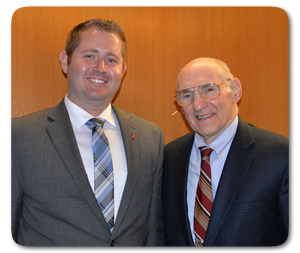Neurosurgery resident tackles big question in spinal cord research, is honored with 2015 Dunsker Award
CINCINNATI – Insights into why decompressive laminectomy is of no help to spinal cord injury patients earned Daniel Harwell, MD, a fifth-year resident in the Department of Neurosurgery at the University of Cincinnati (UC) College of Medicine, the 2015 Ellen and Stewart B. Dunsker, MD, Award for Clinical Research.
The award, which carries a $2,000 prize, was announced during the 32nd Mayfield Neuroscience Symposium at the UC College of Medicine. The event coincided with graduation ceremonies for three neurosurgery residents: Ben Bixenmann, MD, Cyrus King, MD, and Mark Magner, MD.
Dr. Harwell's research was an extension of his collaboration with the late Charles Kuntz, IV, MD, regarded internationally as an expert in complex spinal injury and deformity.
Mario Zuccarello, MD, Chairman of the Department of Neurosurgery and the Frank H. Mayfield Chair, recalled the moment when Dr. Kuntz approached him with a novel idea about spinal cord injury. "I remember Charlie telling me that he had a ‘crazy' idea, but of course he was a genius," Dr. Zuccarello said.
The idea that troubled Dr. Kuntz was this: Following brain trauma, removing a portion of the skull (a hemicraniectomy) successfully reduces pressure in the brain and allows healing to occur. But performing a similar type of procedure following spinal trauma – removing a portion of the spinal vertebrae (a decompressive laminectomy) – has a small effect on swelling and produces little benefit to patients.
Dr. Kuntz enlisted Dr. Harwell to help him explain the conundrum.
Working with fresh cadavers, Dr. Harwell completely removed the brains and spinal cords, placed them in a tub of distilled water, and monitored the pressure changes within the substance of the spinal cord over a period of five days. As expected, the brain automatically swelled. But as the spinal cord swelled it became rigid and whipped around like a tail. In some areas, the cord burst open and herniated. Unlike the brain, the spinal cord was unable to accommodate the pressure within.
"The cause was the pia mater, the thin, fibrous and protective covering of the spinal cord," Dr. Harwell said. "The pia, which is impermeable, prevented any swelling, whereas the folds in the brain allowed for expansion to occur. Our experiment showed why a spinal laminectomy fails to help a patient following spinal injury. Even when provided with extra ‘breathing room,' the cord is unable to take advantage of it."
The next step for researchers, Dr. Harwell says, it to try the experiment in an animal model.
Meanwhile, the answer to Dr. Kuntz's question begs another: "What if the pia were cut to reduce pressure?" Dr. Harwell asks. "That is a possibility in the future."
***
Dr. Dunsker, Professor Emeritus of Neurosurgery and a retired Mayfield Clinic neurosurgeon, and his wife underwrite the Dunsker Award, which is given to a resident who has proposed and completed the most compelling clinical research project during the academic year. "I ask the residents to perform experiments not on their benches but in their brains," Dr. Dunsker said Friday. Asking the question "why" is not expensive and requires no NIH grant, he added. He encouraged residents to "Go find a better way."
Dr. Dunsker, who retired as Professor of Neurosurgery in 2002 after a 31-year career with the Mayfield Clinic, played a role in developing spinal surgery into a subspecialty of neurosurgery. He was named Ohio Neurosurgeon of the Year in 1992 and received the Harvey Cushing Medal, the highest honor bestowed by the American Association of Neurological Surgeons, in 2003. He remains a familiar figure at department meetings and grand rounds.
2015 Dunsker Award entrants were judged by faculty members of the UC Department of Neurosurgery.

Dunsker Award winner Daniel Harwell, MD, left, with Stewart Dunsker, MD.
Dunsker Award Winners:
2008 Andrew Losiniecki, MD
2009 Andrew Grande, MD
2010 Ellen Air, MD, PhD
2011 Dean Hertzler, MD
2012 Chad Farley, MD
2013 Joseph Serrone, MD
2014 Ben Bixenmann, MD
2015 Daniel Harwell, MD
